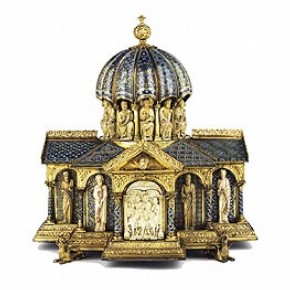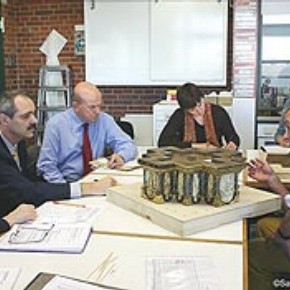Conservation Journal
Summer 2006 Issue 53
Collaborative investigation of the Eltenberg Reliquary

Figure 2. The Eltenberg Reliquary. Photography by Richard Davis, V&A Photographic Studio (click image for larger version)
The so-called Eltenberg Reliquary is one of the V&A's most celebrated and important pieces of twelfth-century ecclesiastical art. It was purchased by the museum in 1861 with a romantic and somewhat uncertain provenance and documentary history. Records suggest that it has had a variety of owners and has also passed through the hands of a number of dealers, who may have enhanced and improved its appearance through restoration.
The reliquary was examined in the Conservation Department, prior to being lent to an exhibition in Essen in spring 2005. Optical microscopy identified inconsistencies in paint application on the inner surfaces of the lid: under ultra-violet light, ivories fluoresced differently, signifying some later additions. 'Older' ivories exhibited localised, green, copper staining, but the associated metalwork was in good condition, suggesting that corroded metalwork had been replaced. From an art-historical perspective the designs on at least one of the enamels were not comparable with known examples of twelfth-century type; whether this indicates that they are authentic, but as yet un-attributed, is not clear.
The correct identification of provenance, date and original technology is necessary to support the Eltenberg reliquary's status as a 'star' object in the Medieval and Renaissance galleries, which are due to open in late 2009.
Only one other example of this type of reliquary is known. Owned by the Kunstgewerbemuseum in Berlin, the so-called Welfenschatz reliquary is very similar in shape, scale and decorative design; so much so, that the idea of them being produced by the same workshop has been suggested.
The Berlin reliquary was extensively investigated by a team of eminent art historians, curators, conservators and scientists in the 1990s, when the reliquary was undergoing conservation treatment. On completion of the work, a number of research questions remained unresolved, which could only be answered or verified by comparative investigation with the Eltenberg reliquary.

Figure 1. The V&A and Kuntsgewerbemuseum Eltenberg Reliquary team discussing interim results (© Saturia Linke, Berlin) (click image for larger version)
The Kunstgewerbemuseum team, lead by Dr Lothar Lambacher, raised the funds to enable the Eltenberg reliquary to be similarly researched. A joint venture agreement was signed in October 2005 between the V&A and the Kunstgewerbemuseum. The work began with meticulous and comprehensive technological drawings and has now proceeded to a detailed examination of individual components, such as the enamels and ivories. Scientific analysis is providing insights into provenance and date, whilst controlled and phased dismantling is revealing considerable evidence of original technology as well as illuminating phases of restoration. By working collaboratively, curators, conservators and scientists in Germany and England are sharing their experience and expertise.
In July 2006 a group of internationally eminent scholars and experts will be invited to discuss the findings of the investigation and examine the components of the reliquary, prior to reconstruction. Subsequently an exhibition, spotlighting the two reliquaries and associated twelfth-century enamels and ivories, will be held at the Kunstgewerbemuseum between September and November 2006. A small catalogue will accompany this exhibition and later an extensive publication will be produced for the academic community.
Summer 2006 Issue 53
- Editorial
- Developing the Islamic Middle East gallery and touring exhibition
- Planning the packing for a touring exhibition
- The traveling technician - the role of a technician as courier
- Harpies - past and present
- Tiles from the tomb of Buyanquli Khan
- Pigment analysis of a Persian album page
- Collaborative investigation of the Eltenberg Reliquary
- Frankfurt Kitchen: patina follows function
- Printer friendly version